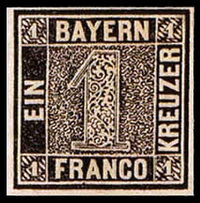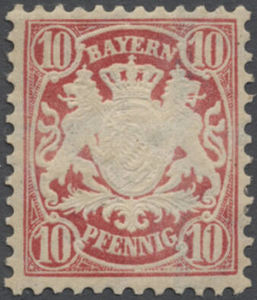

Bavaria is a stamp specialist’s delight. Collectors can collect this country casually and simply, trying to get one of each of the issued stamps (that means about 200 or so varieties). Or, collectors can specialize to their heart’s delight seeking out ring cancellations (showing individual town usages. Ring cancellations are also found on the stamps of Baden), many shade varieties, cancellation varieties, interesting Official stamps, and even semi-official airmail stamps that rank among the earliest issued.
Specialized Catalogs: The Scott Classic catalog for Bavaria is pretty good. But, for the most part, it merely has synthesized and translated parts of what is in the German Michel Specialized catalog Bavaria section, which, if you specialize in this country, is the catalog you must use. Michel is really a work of art—its listings are clear, concise, and conscientious (there are very few “imaginary” shade and perforation varieties that existed only in the minds of long dead specialists and are incomprehensible today). The catalog is updated often, and though some countries and sections are better than others (Bavaria is one of the best), the catalog is consistently and carefully edited. There are many thousands of varieties listed by Michel for the stamps of Bavaria, accurately priced. Many of the varieties cost little more than the main stamp itself which makes the search more interesting.

Availability of Material: Bavaria is one of the most popular subspecialties of the German area, and one of the reasons for its popularity is the abundance of material. As one of the most populous, wealthy, and commercial of the German States (Munich is the capital of Bavaria), as well as having issued many stamps over a long period of time, Bavaria specialists usually find much material on offer.
Expense: What so many specialist like about Bavaria is that it offers all the fun a major country specialty, all the varieties, specialized literature, and postal history at a fraction of the cost of some of the pricier areas. It is a deservedly popular area to collect.
Overall grade: A
